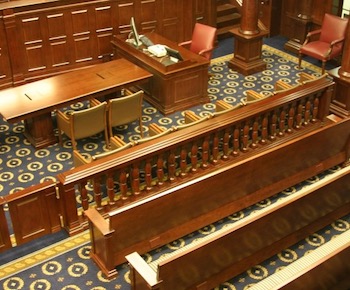The Federal Circuit recently issued a decision that once again addressed the issue of whether an IPR was time-barred. The Court vacated the final written decision of the Patent Trial and Appeal Board (“the Board”) with respect to one of challenged patents because it was time-barred and affirmed the Board’s decision that two other claims from two different patents were invalid as being obvious.See Luminara Worldwide, LLC v. Iancu, Nos. 2017-1629, 2017-1631, 2017-1633, 2018 U.S. App. LEXIS 22836 (Fed. Cir. Aug. 16, 2018) (Before Lourie, Dyk, and Taranto, J.) (Opinion for the court, Dyk, J.)
The case arrived at the Federal Circuit by way of appeal from Luminara Worldwide, LLC, (“Luminara”), the owner of U.S. Patent Nos. 8,696,166 (“the ‘166 patent”), 8,070,319 (“the ‘319 patent”), and 8,534,869 (“the ‘869 patent”), each of which employ moving pendulums to simulate the appearance of a natural flame.In three separate inter partes review (“IPR”) decisions,the Board held unpatentable 31 claims across the three patents. On appeal, Luminara primarily challengedthe Board’sdecisions assertingthat the Board’s application of the 35 U.S.C. § 315(b)time-bar was improper as to one of thepatents-in-suit (the ’319 patent).
In November 2012, Luminara initially filed a complaint against Liown for infringement of the ’319 patent. Service was acknowledged in December 2012. The following year, December 2013, the parties having agreed to a dismissal, the district court entered a voluntary dismissal without prejudice pursuant to FRCP 41(a)(1)(A)(ii) and (B). In August 2014, Luminara commenced another suit against Liown, again alleging infringement of the ’319 patent as to the same products involved in the earlier case. Within one year of service of the second suit, Liown filed for an IPR of the ’319 patent. Luminara argued that Liown was time-barred as to the ’315 patent.
The Board instituted the petition and rejected the timeliness argument because the first suit had been voluntarily dismissed without prejudice. Luminara appealed the time-bar determination of the Board with respect to the ’319 patent. After Liown declined to participate, the United States Patent and Trademark Office intervened to defend the Board’s decision.
In a decision issued the same day, the Court, en banc,considered whether section315(b)’s time-bar applies to bar institution when an IPR petitioner was served with a complaint for patentinfringement more than one year before filing its petition,but the district court action in which the petitioner was soserved was voluntarily dismissed without prejudice. See Click-To-Call Technologies, LP, v. Ingenio, Inc., No. 15-1242 (Fed. Cir. Aug. 16, 2018). In Click-To-Call the en banc court held thatsection 315(b)’s time-bar applies in such a scenario.Thus, because the section 315(b) time-bar applieswhen the underlying complaint alleging infringement hasbeen voluntarily dismissed without prejudice, the Boarderred in instituting the IPR challenging the ’319 patent.Therefore, the Courtvacatedthe Board’s final written decision as to the ’319 IPR and remandedfor dismissal of that IPR.
Luminara challenged the obviousness determination of claim 4 of the ‘319 patent, claim 14 of the ‘166 patent, and claim 34 of the ‘869 patent, based on the belief that the Board allowed the obviousness argument to be changed without giving them notice. The challenge to claim 4 of the ‘319 patent became mooted by the decision that the IPR was to be dismissed as being time-barred. The Federal Circuit disagreed, finding that the obviousness theory did not change during the course of the IPR and, therefore, affirmed the Board.
Take Away
A voluntary dismissal of a patent infringement suit does not nullify the tolling of a time-bar for petitioning for an IPR under 35 U.S.C. § 315(b).

![[IPWatchdog Logo]](https://ipwatchdog.com/wp-content/themes/IPWatchdog%20-%202023/assets/images/temp/logo-small@2x.png)



![[Advertisement]](https://ipwatchdog.com/wp-content/uploads/2024/04/Artificial-Intelligence-2024-REPLAY-sidebar-700x500-corrected.jpg)
![[Advertisement]](https://ipwatchdog.com/wp-content/uploads/2024/04/UnitedLex-May-2-2024-sidebar-700x500-1.jpg)
![[Advertisement]](https://ipwatchdog.com/wp-content/uploads/2024/04/Patent-Litigation-Masters-2024-sidebar-700x500-1.jpg)

![[Advertisement]](https://ipwatchdog.com/wp-content/uploads/2021/12/WEBINAR-336-x-280-px.png)
![[Advertisement]](https://ipwatchdog.com/wp-content/uploads/2021/12/2021-Patent-Practice-on-Demand-recorded-Feb-2021-336-x-280.jpg)
![[Advertisement]](https://ipwatchdog.com/wp-content/uploads/2021/12/Ad-4-The-Invent-Patent-System™.png)






Join the Discussion
No comments yet.